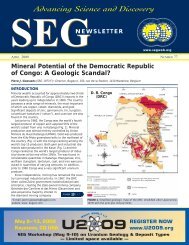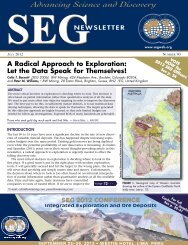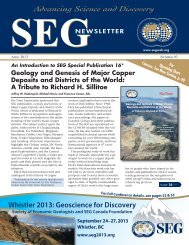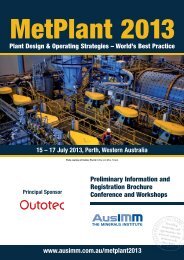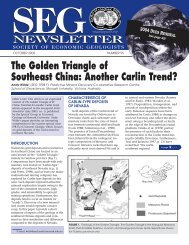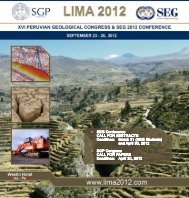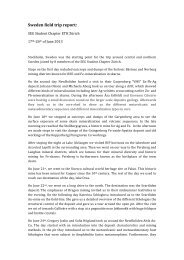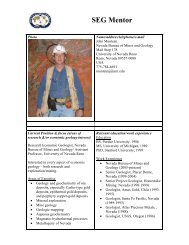SEG 45 Final_qx4 - Society of Economic Geologists
SEG 45 Final_qx4 - Society of Economic Geologists
SEG 45 Final_qx4 - Society of Economic Geologists
You also want an ePaper? Increase the reach of your titles
YUMPU automatically turns print PDFs into web optimized ePapers that Google loves.
22 <strong>SEG</strong> NEWSLETTER No 53 • APRIL 2003<br />
... from 21<br />
<strong>Economic</strong> Geology Commentary (Continued)<br />
<strong>Economic</strong> Geology Commentary<br />
observations made primarily on the<br />
subeconomic, and, most importantly,<br />
relatively undolomitized Cooleen zone<br />
(near Silvermines), have recognized five<br />
main breccia types. Their type I polymictic<br />
and roughly concordant breccia is<br />
“...interpreted to have formed through<br />
episodic, fault-controlled synsedimentary<br />
slumping to create debris flows during<br />
formation <strong>of</strong> the Waulsortian mudbanks...”<br />
(Lee and Wilkinson, 2002, p.<br />
659). Their type III breccia is described<br />
as comparable to the black matrix breccia<br />
at Lisheen and is regarded by these<br />
authors as being originally a type I breccia<br />
that has been overprinted and<br />
altered by regional dolomitization and<br />
hydrothermal processes. The conclusions<br />
<strong>of</strong> Lee and Wilkinson (2002) are<br />
challenged by Reed and Wallace (2003)<br />
but are stoutly defended by Wilkinson<br />
and Lee (2003). Obviously there is no<br />
consensus at this time.<br />
Whether the Lisheen BMB is <strong>of</strong><br />
hydrothermal (Hitzman et al., 2003) or<br />
synsedimentary origin (Lee and<br />
Wilkinson, 2002) does not alter the fact<br />
that these bodies are closely associated<br />
with sulfides and, therefore, will continue<br />
to <strong>of</strong>fer exploration targets many<br />
times the size <strong>of</strong> the associated orebodies.<br />
However, if future detailed studies <strong>of</strong><br />
the Lisheen black matrix breccia confirm<br />
the synsedimentary origin <strong>of</strong> these<br />
breccias, the significance <strong>of</strong> the regional<br />
dolomitization and the resulting<br />
increase in permeability to facilitate the<br />
flow <strong>of</strong> hydrothermal fluids will be<br />
reduced. Hydrothermal fluids, instead,<br />
will be seen as favoring the highly permeable<br />
debris flows and forming sulfide<br />
bodies by open-space filling and<br />
replacement <strong>of</strong> these bodies.<br />
Hitzman et al. (2002) conclude that<br />
formation <strong>of</strong> the Lisheen orebody<br />
required the following: (1) the presence<br />
<strong>of</strong> suitable host rocks; (2) an effective<br />
plumbing system; and (3) metalliferous<br />
NOTE:<br />
hydrothermal fluids. The first <strong>of</strong> these,<br />
the regional dolomitization, occurred<br />
no earlier than the Chadian and<br />
resulted in a significant increase in<br />
porosity and permeability. Regional<br />
dolomitization is considered to have<br />
controlled the size and geometry <strong>of</strong> the<br />
Lisheen deposit. The second, synsedimentary<br />
normal faulting during late<br />
Courceyan to Chadian provided the<br />
necessary channels for ingress <strong>of</strong><br />
hydrothermal fluids. Although the<br />
nature <strong>of</strong> the hydrothermal fluids is not<br />
fully clear, they appear to have been<br />
somewhat acidic, and caused initial formation<br />
<strong>of</strong> the Lisheen breccias followed<br />
by sulfide precipitation. Mineralization<br />
is estimated to have occurred “...at least<br />
10 m.y. after deposition <strong>of</strong> the<br />
Waulsortian complex host rocks”<br />
(Hitzman et al., 2002, p. 1653).<br />
One final note deserves attention:<br />
Hitzman et al. (2003) allude to the difficulty<br />
in correlating radiometric dates<br />
and stratigraphic ages in the<br />
Carboniferous time scale, and three different<br />
time scales proposed by George et<br />
al. (1976), Haq and van Eysinga (1998),<br />
and Okulitch (1999), vary by up to 10<br />
m.y. in the absolute positioning <strong>of</strong> the<br />
various stratigraphic boundaries. These<br />
uncertainties have led to some confusion<br />
in the literature over the timing <strong>of</strong><br />
mineralization in the Irish Zn-Pb<br />
deposits (e.g., Lee and Wilkinson, 2002;<br />
Boyce et al., 2003). It is suggested that<br />
improved absolute age definition <strong>of</strong> this<br />
part <strong>of</strong> the Carboniferous time scale<br />
would help resolve some <strong>of</strong> the outstanding<br />
controversies regarding these<br />
important base metal deposits.<br />
REFERENCES<br />
Boyce, A.J., Little, C.T.S., and Russell, M.J.,<br />
2003, A new fossil vent biota in the<br />
Ballynoe barite deposit, Silvermines,<br />
Ireland: Evidence for intracratonic sea-floor<br />
hydrothermal activity ~352 Ma: <strong>Economic</strong><br />
Geology, v. 98, in press.<br />
George, T.N., Johnson, G.A.L., Mitchell, M.,<br />
Prentice, J.E., Ramsbottom, W.H.C.,<br />
Sevastopulo, G.D., and Wilson, R.B., 1976,<br />
A correlation <strong>of</strong> Dinantian rocks in the<br />
British Isles: Geological <strong>Society</strong> <strong>of</strong> London<br />
Special Reports 7, 87 p.<br />
Haq, B.U. and van Eysinga, F.W.B., 1998,<br />
Geological time scale—fifth edition:<br />
Amsterdam, Elsevier Science.<br />
Hitzman, M.W., Redmond, P.B., and Beaty,<br />
D.W., 2002, The carbonate-hosted Lisheen<br />
Zn-Pb-Ag deposit, County Tipperary,<br />
Ireland: <strong>Economic</strong> Geology, v. 97, p.<br />
1627–1655.<br />
Lee, M.J. and Wilkinson, J.J., 2002,<br />
Cementation, hydrothermal alteration,<br />
and Zn-Pb mineralization <strong>of</strong> carbonate<br />
breccias in the Irish Midlands: Textural evidence<br />
from the Cooleen zone, near<br />
Silvermines, County Tipperary: <strong>Economic</strong><br />
Geology, v.97, p. 653–662.<br />
Mullane, M.M. and Kinnaird, J.A., 1998,<br />
Synsedimentary mineralization at the<br />
Ballynoe barite deposit, near Silvermines,<br />
Co. Tipperary, Ireland: Transactions <strong>of</strong> the<br />
Institute <strong>of</strong> Mining and Metallurgy, v.107,<br />
p. B48–61.<br />
Okulitch, A.V., 1999, Geological time scale,<br />
1999: Geological Survey <strong>of</strong> Canada Open<br />
File 3040, National Earth Sciences Series,<br />
Geological Atlas.<br />
Reed, C. and Wallace, M., 2003,<br />
Cementation, hydrothermal alteration,<br />
and Zn-Pb mineralization <strong>of</strong> carbonate<br />
breccias in the Irish Midlands: textural evidence<br />
from the Cooleen zone, near<br />
Silvermines, County Tipperary—a discussion:<br />
<strong>Economic</strong> Geology, v. 98, 191–193.<br />
Wilkinson, J.J. and Lee, M.J., 2003,<br />
Cementation, hydrothermal alteration,<br />
and Zn-Pb mineralization <strong>of</strong> carbonate<br />
breccias in the Irish Midlands: textural evidence<br />
from the Cooleen zone, near<br />
Silvermines, County Tipperary—a reply;<br />
<strong>Economic</strong> Geology, v. 98, 194–198. 1<br />
Commentary that appears in this column is<br />
solicited by the technical editor.<br />
Dr. Sangster retired from the Geological<br />
Survey <strong>of</strong> Canada in 1997; he is a past<br />
President <strong>of</strong> <strong>SEG</strong>.<br />
All <strong>SEG</strong> members take note <strong>of</strong> their membership<br />
numbers on the mailing label <strong>of</strong> the Newsletter<br />
for access to the <strong>SEG</strong> on-line <strong>of</strong>ferings!



